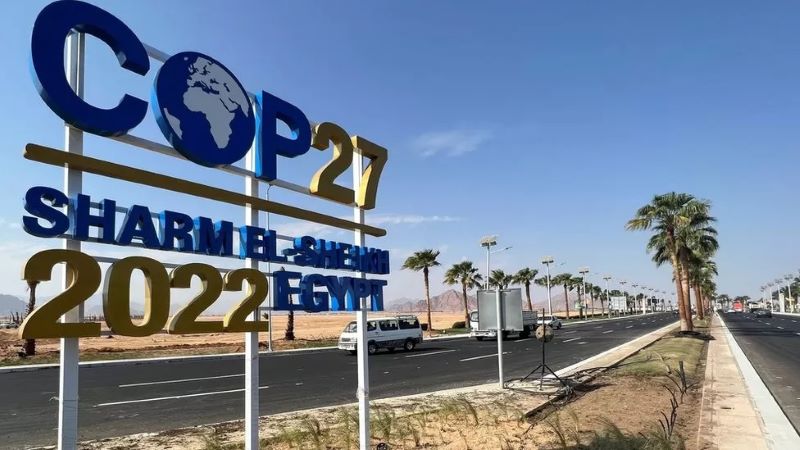New Delhi, November 5, 2022: The world will witness a two-week climate summit starting November 6 in Sharm el-Sheikh, Egypt against the backdrop of the deteriorating climate conditions, soaring global temperatures and the energy crisis triggered by the war in Ukraine. The conference, also called COP or “Conference of the Parties”, is organized by the United Nations (UN) every year for debates and negotiations pertaining to climate change.
Over 35,000 people including dignitaries, government officials, activists, environment advocates and people from civil society along with 100 state heads are expected to be at the meeting. However, the scale would be lower than Glasgow wherein 120 state heads participated, while over 40,000 participants had recorded their registration. The meeting is being held to take into account what has been done so far by the 197 signatory countries to curb greenhouse gas emissions.
The pledge to slash methane gas emissions ,which could eliminate over 0.2˚C warming by 2050, was undertaken by over 100 countries during last year’s deliberations. However, the undertaking is witnessing roadblocks owing to the current pace and lack of prompt action of the parties. The World Meteorological Organization’s Greenhouse Gas Bulletin records that this inertia will make it hard to deliver on the non-binding Global Methane Pledge to cut emissions by 30 percent, by 2030.
In other words, though the COPs are the most important events and a global platform to plan and pledge to protect our environment by cutting down the greenhouse gases and carbon emissions, not much has been accomplished so far as per the plan. This is also evident from the fact that before the COP27 meeting, the signatory countries were asked to submit their national climate plans, however, only 25 countries have done so to date.
The conference has come under scrutiny and is receiving backlash even before its commencement due to a host of unfavourable issues. Being one of the biggest contributors of plastic pollution, the presence of Coca Cola, as one of the sponsors of the event, has also been criticised. Furthermore, an environment activist has been put behind the bars for protesting in Egypt, the host of COP27.
Despite everything, we still need platforms like the COPs. Let’s take a round-up of what we know so far about the COPs.
Why is COP27 a big deal?
Deadly floods in Pakistan, severe drought and Hurricane Ian in the US and the Caribbean, famine in Africa and heat waves across Europe are some of the recent disastrous outcomes of man-made problems. These calamities are proof enough of the impact of environmental degradation on our lives.
COP27: What would be at the core of it?
Though the debate would focus on the steps countries should take to mitigate the crisis of climate change and climate finance, however, unfortunately the ultimate goal of the conference is in dispute. The major issue creating this quandary is that the developed and the wealthy nations want the developing countries to discontinue fossil fuels and transit towards renewable energy, while the developing countries expect finances and funding from the rich nations to tackle the climate-fuelled disasters they are experiencing.
COP27: Background and what happened at COP26?
An agreement among the 200 nations was signed, which is called Glasgow Pact. According to the agreement, the countries were requested to revisit and strengthen their greenhouse gas emission targets by the end of 2022 by controlling the rise of global temperature within 1.5 degree Celsius, which would be at par with the global levels before the industrial revolution.
Contrary to the commitments, as another major outcome of the COP26, it was noted that the rich nations have failed to deliver on their decade-old promise of investing $ 100 billion annually, by 2020 towards climate change. The conference urged them to double the finances by 2025.
In addition, over 100 signatory nations had pledged to cut methane emissions by 30% in this decade. Furthermore, 130 countries had vowed to stop deforestation by 2030 and fund this effort with billions of dollars. Several other nations pledged to phase out the coal plants and its use, along with putting an end to sales of gasoline-powered vehicles over the next few decades.
COP – Damages so far and challenges ahead
Climatic effects and disasters that countries are observing at present are the direct outcome of the inability of nations to implement these policy changes. This has had a head-on bearing on the human race. For instance, due to rising sea levels have forced thousands to relocate from the coastline in Fiji. Moreover, finding shelter for over 30 million people displaced by floods in Pakistan is a serious concern.
Now, the challenge ahead is that at least the 200 signatory countries deliver as per their promises and fund developing and poor nations so that they can quickly adapt to more sustainable ways to control the climate crisis.
COP - Origin and history
The first COP was held in 1995 in Berlin. The first climate summit saw a mass attendance and set the stage for the Kyoto Protocol, an agreement that was considered a landmark at that time. According to the Kyoto Protocol, the focus was on developed, wealthy, industrialized nations to curb emissions, while it wanted the developing nations like China, India and Brazil to curb emission voluntarily.
This was, however, opposed by the US Senate and thereafter the world witnessed an ongoing debate for almost two decades as to which countries hold the biggest responsibility to tackle climate change.
In 2015 however, the Barack Obama government initiated the process and brought nearly 200 nations on the same page to sign the groundbreaking Paris Climate Agreement. As per the agreement, all nations, rich or poor, decided to act to tackle the climate change, though at a different pace. Later on, under the leadership of Donald Trump, the US withdrew itself from the Paris agreement, however, rejoined under Joe Biden’s government.









.jpg)




